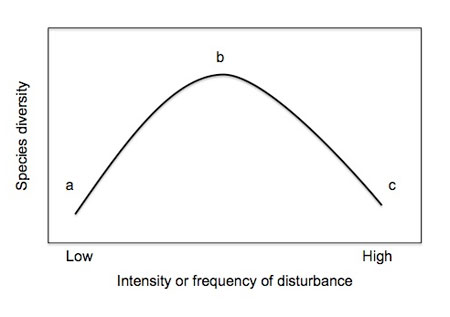3.2 General Ecology
Competition
Competition over resources like food, space
Intraspecific - competition for mates, food, light, water, space
Interspecific - food, light, water, space
On the Reef - Competition for space is huge
intraspecific - two corals fight for space or out-shade each other
Interspecific - algae vs. coral for space, light, nutrients
competitive exclusion principle - two species which compete for the same limited resources, one species out-competes the other
Niche Partitioning
Ecological niche - the sum of all resources both biotic and abiotic that an organism uses in its lifetime
prevents direct competition for a reosurce
Fundamental niche - the ideal niche an organism could optimally have
Realized niche - the real niche that isn't optimal
Resource Partitioning - when similar species settle into different niches that allow them to coexist
ex. MacArthur's warblers thought to have identical niches actually varied slightly to use different parts of the tree and mated at different times of the year so that their maximum nutritional periods didn't overlap
Character displacement - when similar species overlap geographically, the things that make them different (niche differentiation) is exacerbated in the overlapping area, but the differences are lost when the species don't overlap
ex. Grant's finches
Succession & Ecosystem Assembly
Succession
Disturbances - very common, various scales
Primary succession - when life occupies a landscape for the first time. No competition
build or re-build soils
Pioneer species -
Secondary succession - common after a small disturbance, caused by a change in a microclimate that allow different species to come in and fill the niche
Climax community - idealized community that will result after series of succession has stabilized. more theoretical than practical because there is constant change in nature
higher succession level indicated by high biodiversity
Stochasticity - element of unpredictable variability
Assembly Rules
historical patterns of speciation, migration, dispersal, abiotic environmental factors, biotic interactions
The enemy of my enemy is my friend - trophic cascade
Timing is the key to success - species that arrive first often survive because they have space and nutrient access
Access Denied - when a species goes extinct in a system, it is often unable to re-invade successfully
predator cannot invade a new community without prey
1 forbidden species combinations - competition not random immigration drives species competition on islands
2 reduced niche overlap - species occurring on islands together should be more specialized and therefore have less niche overlap
Island Biogeography
Island diversity - determined by rate of new species arrival and extinction rate (these have inverse relationships, so the predicted number of species is where they overlap)
Island Size Effect - larger islands can have more species because they have higher immigration and lower extinction
Islands are geographically isolated, animals with high dispersal capability are more likely on islands
Low predation & competition
speciation & extinction happen faster on islands
This theory can apply to habitat fragmentation -> conservation
Intermediate disturbance hypothesis

low disturbance allows the dominant species can exclude competitors to completely take over
high disturbance kills everything
medium/intermediate open new niches and allows for new species to establish
an organism without which the entire ecosystem would not exist or would be completely different
Often either a primary producer or top predator
Usually control the ecosystem either through engineering or food web dynamics
Reefs shift between corals and macrolagae, but because coral takes so long to grow, its pretty unidirectional
engineer species determine the structural complexity and food web dynamics of the entire ecosystem

References
Last updated